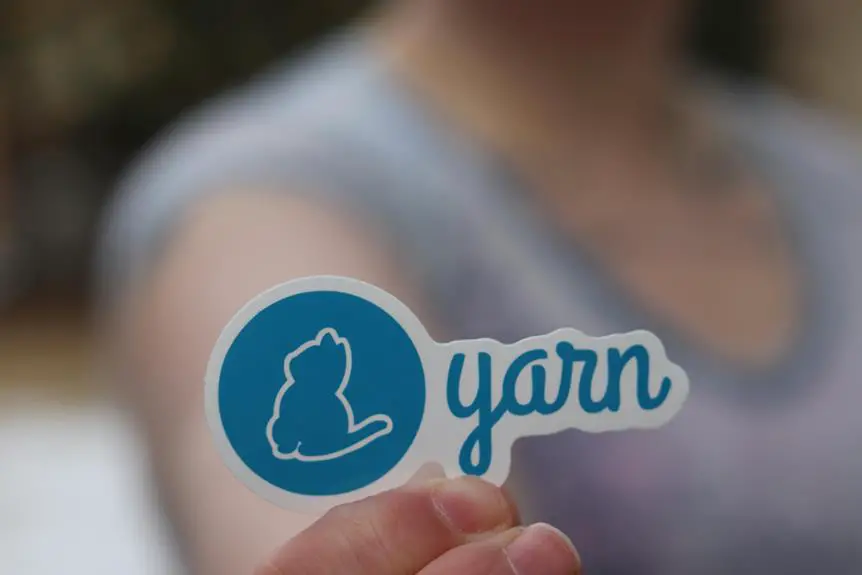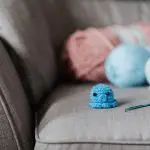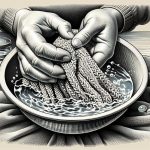Are you using the right yarn count for your projects? Understanding the importance of yarn count is essential for achieving the desired texture, drape, and gauge in your knitting or crochet work.
This guide will provide you with the knowledge and expertise needed to select the appropriate yarn count for your specific projects. By considering factors such as yarn weight, texture, and gauge, you can ensure that your finished piece meets your expectations.
Whether you are a seasoned crafter or looking to enhance your skills, mastering the art of choosing the right yarn count will elevate the quality of your handmade creations.
Key Takeaways
- Yarn count accuracy is crucial for achieving desired specifications in knitted fabrics.
- Yarn weight determines the suitability for different projects and affects gauge and texture in the knitted fabric.
- Fiber type, fiber length, and spinning method all impact yarn count selection.
- Yarn density directly influences yarn count and fabric characteristics, and can be influenced by fiber type, spinning method, twist level, and finishing processes.
Importance of Yarn Count
If you want to create high-quality, consistent fabrics, you need to pay close attention to the yarn count you're using. Yarn count accuracy is crucial in ensuring that your knitted fabrics meet the desired specifications.
In knitting, yarn count refers to the thickness or fineness of the yarn. It's typically expressed as the number of hanks per pound or the number of meters per gram. Using the correct yarn count is essential for achieving the intended texture, drape, and appearance of the knitted fabric.
Inaccuracies in yarn count can lead to variations in fabric density and weight, affecting the overall quality of the knitted product. To maintain precision in your knitting projects, it's imperative to carefully select yarns with the appropriate count. By doing so, you can achieve uniformity in your knitted fabrics, resulting in a professional and polished outcome.
Understanding the significance of yarn count in knitting empowers you to make informed decisions when selecting materials for your projects. Paying attention to yarn count accuracy demonstrates your commitment to mastering the art of knitting and producing high-caliber fabrics.
Understanding Yarn Weight
Understanding yarn weight is essential for determining the suitability of the yarn count in achieving the desired texture, drape, and appearance of your knitted fabric. Yarn weight refers to the thickness of the yarn and plays a crucial role in the outcome of your knitting project.
Here are some key points to help you understand yarn weight:
- Yarn Weight Categories: Yarn is categorized into different weights, ranging from lace (super fine) to jumbo (super bulky). Each weight category has its own unique characteristics and recommended needle or hook size.
- Yarn Weight and Project Suitability: Understanding the relationship between yarn weight and the intended project is important. For example, lace or fingering weight yarn is suitable for delicate shawls or lightweight garments, while bulky or super bulky yarn is ideal for cozy blankets and winter accessories.
- Yarn Count Comparison: While yarn weight focuses on thickness, yarn count refers to the fineness or coarseness of the yarn. It's important to consider both yarn weight and count when selecting yarn for your project to ensure the desired results.
- Impact on Gauge and Texture: Yarn weight directly affects the gauge of your knitting and the texture of the finished fabric. Different yarn weights produce varying levels of drape, stitch definition, and overall appearance in the knitted fabric.
Factors Affecting Yarn Count
When choosing the right yarn count, it's crucial to consider the factors that can impact it.
The type of fiber used can significantly affect the yarn count, as different fibers have varying thickness and weight.
Additionally, the method of spinning the yarn and the density of the yarn also play key roles in determining the final yarn count.
Fiber Type Impact
Choosing the appropriate yarn count depends on the specific fiber type you're working with. The fiber type impacts yarn quality and, therefore, affects the selection of yarn count. Consider the following factors when evaluating the impact of fiber type on yarn count:
- Fiber Length: Longer fibers often require finer yarn counts, while shorter fibers are better suited for coarser yarn counts.
- Fiber Elasticity: Highly elastic fibers may require a tighter yarn count to maintain structural integrity.
- Fiber Strength: Stronger fibers can withstand higher tension, allowing for a finer yarn count.
- Fiber Fineness: Finer fibers generally require finer yarn counts to fully showcase their delicate nature.
Understanding how different fiber types interact with yarn count is crucial for achieving the desired characteristics in the final knitted or woven product.
Yarn Spinning Method
Are you adjusting your yarn count based on the spinning method used, as it significantly impacts the resulting fabric's texture and drape?
Spinning techniques play a crucial role in determining the yarn count and, consequently, the characteristics of the fabric. For instance, yarns produced using the ring spinning method tend to be stronger and have a smoother surface, resulting in a finer yarn count compared to yarns produced using the open-end spinning method.
Understanding the impact of spinning techniques on yarn count is essential for achieving the desired fabric properties. Therefore, when comparing yarn counts, it's important to consider the spinning method employed to ensure that the resulting fabric meets the specific requirements for texture, drape, and overall performance.
Yarn Density Influence
Did you know that yarn density, which includes factors such as the number of fibers per unit length and the compactness of the yarn structure, directly influences the yarn count and, consequently, the characteristics of the fabric?
Understanding how yarn density influences fabric structure is crucial for achieving the desired properties in your textiles. Consider the following factors affecting yarn density and fabric structure:
- Fiber Type: Different types of fibers have varying densities, which affect the overall yarn density.
- Spinning Method: The method used to spin the yarn can impact its density and, consequently, the fabric's characteristics.
- Twist Level: The twist in the yarn affects its density and, in turn, influences the fabric's structure.
- Yarn Finishing: The finishing processes applied to the yarn can alter its density and impact the fabric's properties significantly.
Mastering yarn density and its influence on fabric structure is essential for producing high-quality textiles.
Choosing Yarn Count for Texture
Make sure to factor in the yarn count when aiming for a specific texture in your project. The yarn count plays a crucial role in determining the elasticity and drape of your fabric.
For a project requiring elasticity, opt for a finer yarn count such as a fingering or sport weight yarn. These yarns have more plies and provide better stretch, making them ideal for items like socks or fitted garments.
Conversely, if you desire a drapey texture, consider using a heavier yarn with a lower yarn count such as a DK or worsted weight. The thicker yarn will create a fabric with more fluidity and movement, perfect for shawls or drapey cardigans.
Additionally, the yarn count significantly impacts stitch definition. A finer yarn count, like a lace weight yarn, can showcase intricate stitch patterns with clarity, making it ideal for detailed lacework or delicate textures. Conversely, a heavier yarn count, such as a bulky weight, may obscure intricate stitch work but can create bold, defined textures in simpler stitch patterns, perfect for cozy blankets or warm winter accessories.
When choosing a yarn count for texture, consider both the desired elasticity and drape as well as the stitch definition required for your project.
Yarn Count for Drape and Feel
When selecting yarn count for your project, it's essential to consider the impact on drape and feel. The yarn count directly affects how the fabric will hang and move, as well as the overall tactile experience.
Understanding how yarn count influences drape and feel will help you make informed decisions for achieving the desired characteristics in your knitted or woven pieces.
Yarn Count Affects Drape
Choosing the right yarn count significantly impacts the drape and feel of your fabric. The drape and feel of your fabric can be affected by the yarn count in several ways:
- Elasticity: Yarn count influences the elasticity of the fabric. Finer yarns tend to produce a more flexible and drapey fabric, while thicker yarns result in less stretch and drape.
- Stitch Definition: Yarn count plays a crucial role in stitch definition. Finer yarns create more defined stitches, which can enhance the overall texture and drape of the fabric.
- Softness: Finer yarns often result in a softer, more luxurious feel, which can greatly impact the drape and comfort of the fabric.
- Weight: The weight of the yarn also affects the drape, with lighter yarns generally producing a more fluid and graceful drape compared to heavier yarns.
Yarn Count Influences Feel
Understanding how yarn count influences the feel of your fabric is crucial for achieving the desired drape and comfort in your projects. The yarn count directly impacts the texture, softness, and durability of the final fabric. A finer yarn count generally results in a smoother, softer fabric, while a coarser yarn count can create a more textured and sturdy fabric. Additionally, the yarn count can influence the color vibrancy of your project, with finer yarn counts often producing more vivid colors due to the increased number of fibers per inch. Consider the table below to understand how different yarn counts can influence the feel and overall quality of your fabric:
| Yarn Count | Texture | Softness | Durability |
|---|---|---|---|
| Fine | Smooth | Soft | Lower |
| Coarse | Textured | Sturdy | Higher |
| Medium | Balanced | Moderate | Medium |
Selecting Yarn Count for Gauge
Make sure you're selecting the right yarn count for your gauge to achieve the desired results in your knitting or crocheting projects.
When it comes to selecting yarn count for gauge, there are a few key considerations to keep in mind:
- Yarn Count for Tension: The yarn count significantly affects the tension in your project. A finer yarn count will generally produce a tighter tension, while a thicker yarn count will result in a looser tension. Be mindful of the yarn count to ensure your gauge matches the pattern requirements.
- Selecting Yarn Count for Color Work: If you're planning to incorporate color work into your project, carefully choose the yarn count to ensure that the colors blend harmoniously. Different yarn counts can produce varying effects when used in color work, so consider the visual impact you want to achieve.
- Understanding Gauge Requirements: Take into account the gauge requirements of your pattern when selecting yarn count. Ensure that the yarn count you choose aligns with the specified gauge to achieve the intended size and structure of your project.
- Experimenting with Swatches: It's always beneficial to create swatches using different yarn counts to see how they affect the gauge. This experimentation can help you determine the ideal yarn count for your specific project, ensuring that your finished piece meets your expectations.
Yarn Count for Specific Projects
To achieve the best results, start by selecting the appropriate yarn count for your specific knitting or crocheting project. The yarn count plays a crucial role in determining the outcome of your project, especially when it comes to temperature control and colorwork patterns. Different projects require different yarn counts to achieve the desired results. When considering yarn count for temperature control, it's important to understand that finer yarns provide better insulation, making them suitable for lightweight garments, while heavier yarns offer warmth and coziness for cold weather. On the other hand, when working on colorwork patterns, selecting yarn with the right thickness is essential to ensure that the colors are showcased beautifully and the stitches are well-defined. Below is a table to guide you in selecting the appropriate yarn count for your specific projects:
| Project Type | Yarn Count | Suitable Yarn Weight |
|---|---|---|
| Temperature Control | Fine yarn (high count) | Lace, Fingering, Sport |
| Colorwork Patterns | Medium yarn (medium count) | Worsted, Aran |
Tips for Matching Yarn Count
When selecting yarn for your project, consider the recommended yarn count to ensure compatibility with your pattern and desired outcome. Matching yarn count is crucial for achieving the right gauge and texture.
Here are some tips for matching yarn count:
- Yarn Count for Colorwork: When working on colorwork projects, such as Fair Isle or intarsia, ensure that the yarn counts of the different colors match. Consistent yarn count will help maintain an even tension and prevent one color from overpowering the others.
- Yarn Count for Durability: For projects that require durability, like socks or items that will undergo frequent washing, opt for yarn with a higher count of plies. A higher ply count adds strength and resilience to the yarn, making it more suitable for long-lasting, hard-wearing items.
- Check Yarn Labels Carefully: Always read yarn labels to identify the yarn count recommended by the manufacturer. This information is crucial for selecting the right yarn for your project and ensuring the best results.
- Utilize Yarn Samples: Before starting a large project, make a small swatch using the yarn and needles you intend to use. This will help you determine if the yarn count is suitable for your pattern and desired fabric texture.
Matching yarn count is essential for the success of your knitting or crochet project. By carefully considering the yarn count for colorwork and durability, checking yarn labels, and using yarn samples, you can ensure that your chosen yarn is the perfect match for your project.
Frequently Asked Questions
How Does Yarn Count Affect the Durability and Longevity of a Knitted or Crocheted Item?
Choosing the right yarn count is crucial for durability and longevity. It affects how tightly the fibers are spun, impacting the item's strength. Consistent gauge and appropriate fiber content also play key roles. Selecting the right color complements the final product.
Can Different Yarn Counts Be Used Interchangeably in a Pattern, or Will It Significantly Affect the Outcome?
Using the right yarn weight is crucial for pattern compatibility. Different yarn counts can affect tension consistency and the outcome of your project. Also, consider yarn fiber content for durability and longevity of your creation.
Are There Any Specific Dyeing or Color Variations to Consider When Choosing a Yarn Count for a Project?
When choosing a yarn count for a project, consider dyeing considerations and potential color variations. The yarn count can significantly impact the project's outcomes, so it's essential to choose the right one for your desired result.
How Does Yarn Count Impact the Stitch Definition and Overall Appearance of a Finished Project?
Choosing the right yarn weight affects stitch definition and overall appearance. Adjusting stitch tension impacts drape and texture. Consider fiber content and texture preferences when selecting yarn count for a polished finished project.
What Are Some Common Mistakes to Avoid When Selecting the Right Yarn Count for a Specific Project?
When choosing yarn weight, common mistakes like overlooking project suitability, fiber content, and tension control can impact your finished product. Be mindful of these factors to ensure your yarn choice complements your project perfectly.
- How Does Ring Spun Cotton Affect Garment Fit and Shape Retention? - August 13, 2024
- What Are the Challenges in Producing Ring Spun Cotton? - August 13, 2024
- Is Ring Spun Cotton Suitable for Plus-Size Clothing? - August 13, 2024




